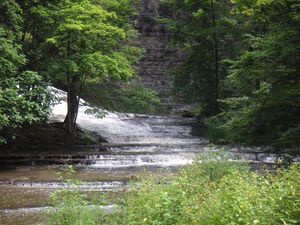Upland and lowland
This article needs additional citations for verification. (October 2022) |
The topic of this article may not meet Wikipedia's general notability guideline. (October 2022) |

Upland and lowland are conditional descriptions of a
are classified as upland or lowland.Definitions
Upland and lowland are portions of plain that are conditionally categorized by their elevation above the sea level. Lowlands are usually no higher than 200 m (660 ft), while uplands are somewhere around 200 m (660 ft) to 500 m (1,600 ft). On unusual occasions, certain lowlands such as the Caspian Depression lie below sea level.
Upland habitats are cold, clear and rocky whose rivers are fast-flowing in mountainous areas; lowland habitats are warm with slow-flowing rivers found in relatively flat lowland areas, with water that is frequently colored by sediment and organic matter.
These classifications overlap with the geological definitions of "upland" and "lowland". In
Much freshwater fish and invertebrate communities around the world show a pattern of specialization into upland or lowland river habitats. Classifying rivers and streams as upland or lowland is important in freshwater ecology, as the two types of river habitat are very different, and usually support very different populations of fish and invertebrate species.
Uplands
In freshwater ecology, upland rivers and
The generally clear, cool, fast-flowing waters and bedrock and coarse sediment beds of upland rivers encourage fish species with limited temperature tolerances, high oxygen needs, strong swimming ability and specialised reproductive strategies to prevent eggs or larvae being swept away. These characteristics also encourage invertebrate species with limited temperature tolerances, high oxygen needs and ecologies revolving around coarse sediments and interstices or "gaps" between those coarse sediments.
The term "upland" is also used in wetland ecology, where "upland" plants indicate an area that is not a wetland.[1]
Lowlands

The generally more
Lowland alluvial plains
- American Bottom—flood plain of the Mississippi River in Southern Illinois
- Bois Brule Bottom
- Bottomland hardwood forest—deciduous hardwood forest found in broad lowland floodplains of the United States
See also
- Freshwater biology
- Highland
- Mountain river
- River reclamation
- Riparian zone
References
- U.S. Army Corps of Engineers. Archived(PDF) from the original on October 12, 2022. Retrieved October 11, 2022.
- ^ Staniszewski, Ryszard; Jusik, Szymon; Kupiec, Jerzy (January 1, 2012). "Variability of Taxonomic Structure of Macrophytes According to Major Morphological Modifications of Lowland and Upland Rivers With Different Water Trophy". Nauka Przyroda Technologie. 6.


